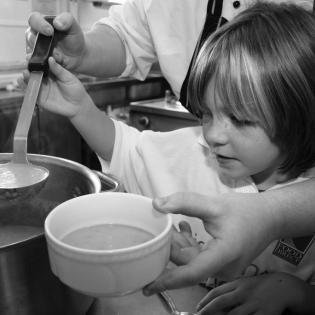We Are Philanthropists: Souperservice Families
The entire family is invited to a family night to assemble dried soup kits to donate to a local food pantry. They may use the dehydrated vegetables from lesson one and other ingredients or contact a food-packing organization that provides the ingredients, and you provide the volunteers.
The learner will:
- assemble a dried soup mixture with the help of an adult volunteer.
- donations or funding to bring together each food and spice in the recipe (see handout below)
- copies of the Harvest Sand Art Soup Recipe (to attach to jars or bags of the mix)
- yarn or ribbon cut to attach the recipe to the jars
- hole punch
- quart jars and new canning lids and rims for each jar
- plastic food wrap
- large and small bowls or plastic containers to hold foods for assembly line
- long tables for the assembly line
- stand-up cards that clearly show the measurement of each ingredient (i.e., 1/2 cup of rice)
- measuring cups or measuring spoons in each container
Families are involved in an evening event that raises awareness of the simple ways that we can be involved in philanthropy projects in our communities. The families gather to assemble jars of dried soup mix. Later families, or the group, will bring the jars to a local soup kitchen.
Instructions
Anticipatory Set:
Show the children an image of a commercially prepared dried soup mix and read the nutrition facts. A mix like this is a way for a family to eat healthy meal for a small amount of money. Tell them they are going to use their talent and skills to prepare some soup mixes to donate to the pantry/food pantry they learned about in lesson three.
Show the video about philanthropy, and say that they are going to be philanthropists together for their community. Invite them to donate the ingredients for the soup mixes. This will take some communication with families to gather the ingredients and get volunteers to help organize the event. A local funder may help you purchase the ingredients, especially if the children make a video requesting funds.
Involve the children in preparing for the family night of soup assembly, including writing invitations and planning how the soup jars or bags will look.
Family Night:
- Show the Philanthropy video, and discuss why volunteering and giving is good for our community.
- Explain the assembly project (handwashing and gloves are critical) and tell them about the soup kitchen or other organization where the soup will be donated.
- There is one table set up with assembly ingredients and instructions. Another table is for decorating the labels and writing notes to go with the soup mixes.
- Volunteers oversee families assembling the ingredients. Children practice measuring.
Reflect on the project at the family night, sharing children's work and discussing the value of community health and generosity.
Arrange to have the children deliver the gift to the food pantry so they can learn about the nonprofit's work and to get a genuine thanks for their philanthropy.
Handouts
Philanthropy Framework
-
Strand PHIL.I Definitions of Philanthropy
-
Standard DP 01. Define Philanthropy
-
Benchmark E.1 Define philanthropy as the giving and sharing of time, talent, or treasure intended for the common good.
-
-
Standard DP 02. Roles of Government, Business, and Philanthropy
-
Benchmark E.6 Explain why acting philanthropically is good for the community, state, nation, or world.
-
-
Standard DP 04. Operational Characteristics of Nonprofit Organizations
-
Benchmark E.1 Describe how citizens organize in response to a need.
-
-
-
Strand PHIL.II Philanthropy and Civil Society
-
Standard PCS 02. Diverse Cultures
-
Benchmark E.4 Demonstrate listening skills.
-
-
Standard PCS 05. Philanthropy and Government
-
Benchmark E.1 Define community as the degree that people come together for the common good.
-
-
-
Strand PHIL.IV Volunteering and Service
-
Standard VS 01. Needs Assessment
-
Benchmark E.1 Identify a need in the school, local community, state, nation, or world.
-
-
Standard VS 03. Providing Service
-
Benchmark E.3 Describe the task and the student role.
-
-
Standard VS 05. Integrating the Service Experience into Learning
-
Benchmark E.2 Evaluate progress on the service-learning project before, during, and after the project.
-
Benchmark E.3 Identify outcomes from the service.
-
-
